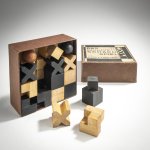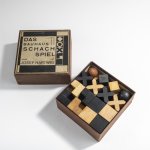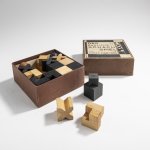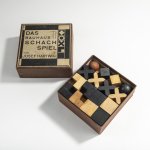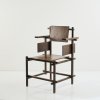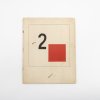Lot: 59
Josef Hartwig
Bauhaus - 'XVI' chess set, 1924
32 figures. H. 2.1-4.7 cm.
Bauhaus Weimar.
Maple wood, partially stained black. Cardboard lined with paper.
Head of the White Queen replaced sometime in the past. Box: H. 5.2 x 12.4 x 12.4 cm, designed by Joost Schmidt, 1923/ 24.
Hammer Price: 8,000 €
03. December 2024 at 5:00 PM CET
Literature:
Josef Hartwig's chess set is one of the most successful products designed at the Weimar Bauhaus. In 1922, the graduate of the Munich Academy, who worked as a foreman in the wood and sculpture workshops at the Weimar Bauhaus from 1921 to 1925, began designing a chess set that was fundamentally different from traditional forms. Hartwig designed the pieces from simple stereometric bodies: cubes, cylinders and spheres. Initially, the pieces were made by hand, but the aim was industrial production. Hartwig himself explained the genesis of the shapes in 1924: "The pawn and rook move at right angles to the edge of the board: expressed by the cube. The knight moves at right angles in the shape of a hook on four squares: four cubes combined at right angles. The bishop moves diagonally to the edge of the board: a diagonal cross cut out of the cube. The king moves at right angles and diagonally: a small cube across a larger one. The queen, the most mobile figure, consists of a cylinder and a sphere.” (The Bauhaus chess game by Josef Hartwig, p. 8). Bauhaus-Archiv Berlin, The Bauhaus chess game by Josef Hartwig, Berlin 2006, p. 19; Hahn, Experiment Bauhaus, Dessau 1988, p. 401; Bauhaus-Archiv, collection catalogue, Berlin 1987, pp. 149-50, cat. no. 288; exhibition cat. Bauhaus 7, Galerie am Sachsenplatz, Leipzig 1991, ill. p. 43, cat. no. 134.
Read our Terms & Conditions.




